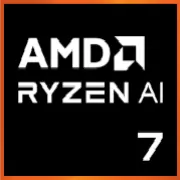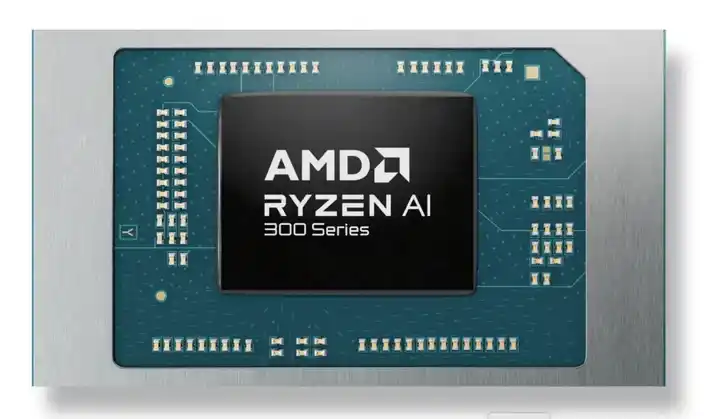AMD Ryzen AI 7 350

AMD Ryzen AI 7 350: a compact Zen 5 with a focus on versatility
Key specifications
-
Cores/threads: 8 / 16 (4× Zen 5 + 4× Zen 5c)
-
Process: 4 nm
-
Max clocks: up to 5.0 GHz on Zen 5 cores; ~3.5 GHz on Zen 5c
-
L3 cache: 16 MB
-
Graphics: Radeon 860M (RDNA 3.5), 8 compute units
-
Memory: DDR5-5600 or LPDDR5X-8000 (dual-channel)
-
I/O: PCIe 4.0, USB4 (up to 40 Gbps)
-
NPU: XDNA 2 up to 50 TOPS
-
Power envelope: baseline around 28 W; configurable 15–54 W (OEM-dependent)

Positioning
Ryzen AI 7 350 sits in the Krackan Point family—mobile Zen 5 APUs designed for thin-and-light laptops, mid-range study and work machines, and compact workstations with a discrete GPU. The core idea is a hybrid of performance Zen 5 and efficient Zen 5c cores, keeping the system snappy under load and frugal at idle.
CPU architecture: Zen 5 + Zen 5c
The 4× Zen 5 + 4× Zen 5c mix yields 16 threads and a wide operating “range”:
-
Zen 5 handles peaks—compiles, rendering, heavy encoding;
-
Zen 5c sustains background multitasking and extends battery life.
The IPC uplift over Zen 4 is most noticeable in snappy single- and lightly-threaded work and interactive workflows.
Integrated graphics: Radeon 860M
The RDNA 3.5-based Radeon 860M packs 8 CUs at high clocks. It’s ample for everyday graphics, 4K video, UI acceleration, and light 3D. For AAA gaming at ultra settings you’ll want a discrete GPU; with an eGPU over USB4/Thunderbolt and adequate cooling, interesting pairings are possible.
Memory and interfaces
The dual-channel controller supports DDR5-5600 and LPDDR5X-8000—memory choice directly affects iGPU bandwidth and overall responsiveness. For I/O you get PCIe 4.0 (for SSDs and dGPU in applicable designs) and USB4 up to 40 Gbps for fast peripherals and docks.
NPU: XDNA 2 up to 50 TOPS
A dedicated AI engine offloads CPU/GPU for on-device tasks—speech features, noise suppression, auto-framing, and some generative/summarization models. That trims power draw in “smart” workflows and keeps more inference local for privacy.
Power, thermals, and acoustics
Laptop makers set their own power limits: from 15–20 W in ultra-thin designs to 45–54 W in performance-oriented models.
-
Low profiles favor battery life and quiet operation but lower sustained clocks under long loads.
-
High profiles boost sustained frequency and throughput, at the cost of stronger cooling requirements.
Performance: grounded expectations
In typical configs, the Ryzen AI 7 350 feels confident in office suites, IDEs, and a browser with dozens of tabs, speeds up builds, photo exports, and video encoding (especially with a fast SSD and dual-channel LPDDR5X). Under extended stress, results hinge on the specific laptop’s power limits and cooling efficiency.
Who it’s for
-
Entry-to-mid content creators. Photo pipelines, social-video edits, proxy workflows, accelerated exports.
-
Mobile developers. Builds, containers, local LLM helpers and tools—without brutal battery hit.
-
Students and office users. Multitasking, video calls with AI filters, large browser workspaces.
-
Compact workstations. Paired with a discrete GPU, the chip shines in on-site CAD/render tasks.
What to look for in a laptop
-
Memory: 16 GB minimum, 32 GB preferred; LPDDR5X-8000 noticeably lifts iGPU and system snap.
-
SSD: NVMe PCIe 4.0 with strong write speeds—key for encoding and cache-heavy workloads.
-
Cooling: dual fans and substantial heatpipes in 35–54 W models improve frequency stability.
-
Ports: USB4 for docks, fast external SSDs, and (potentially) eGPU.
Bottom line
Ryzen AI 7 350 is a well-rounded new-gen “midranger”: a Zen 5/Zen 5c hybrid, capable integrated graphics, fast memory controller, and a powerful NPU. It scales from ultrabooks to compact workhorses and covers a wide range of tasks without awkward compromises. Real-world performance ultimately depends on the specific laptop—its cooling, memory type, and chosen power profile.
Basic
CPU Specifications
Memory Specifications
GPU Specifications
Miscellaneous
Benchmarks
Compared to Other CPU
Share in social media
Or Link To Us
<a href="https://cputronic.com/index.php/cpu/amd-ryzen-ai-7-350" target="_blank">AMD Ryzen AI 7 350</a>